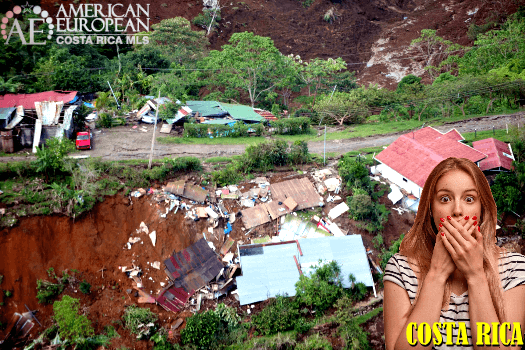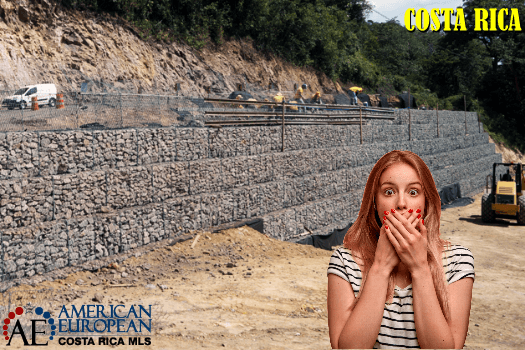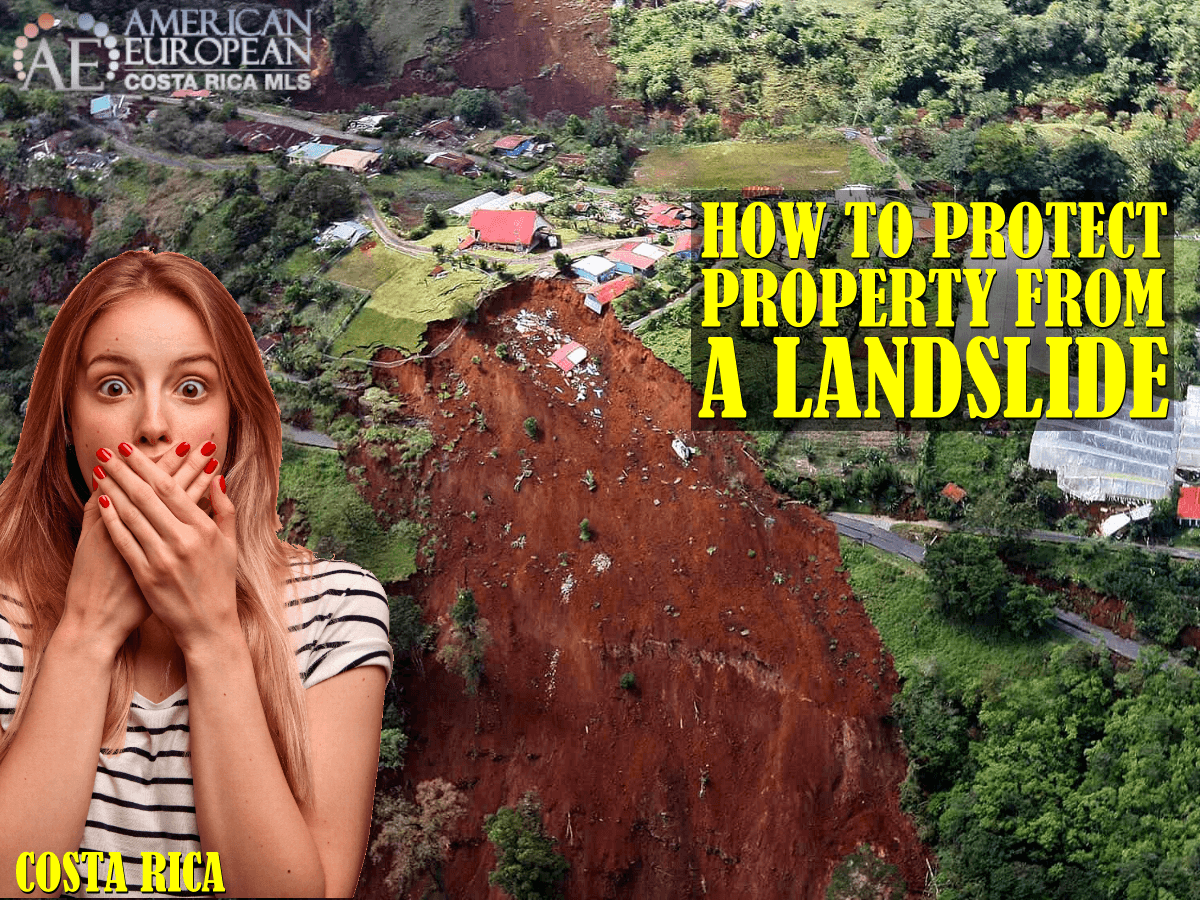Estimated Reading Time: 8 Minutes
Watch out for mud or landslide! A landslide can make your property disappear overnight; did you know that? The image on the left is in Cinchona, where an earthquake in January 2009 – Richter magnitude 6.2, took 34 lives and destroyed many properties.
Buying a property in Costa Rica is not so easy to do so on your own. Then, of course, you can hire the best attorney in the world to protect you against legal problems. But what happens if your property disappears because of a landslide or a mudslide? And you or your family can lose your life during a slide.
I’m not an expert on landslides or mudslides, I’m just a simple real estate broker with over 30 years of selling property in Costa Rica. This blog is meant as a warning, so you can protect yourself from buying a property that might be in danger of disappearing overnight or killing you and your family.
A good example of constant landslides is the Autopistas del Sol concessionary of Route 27, which encountered many problems with an existing highway when they signed for the concession. For those who don’t know the history of Route 27, this highway was designed in 1978. Due to financial and political problems, and bad management, the highway was opened thirty-two years later. In 2006, Autipistas del Sol signed a concession with the government.

Due to bad design, and problems with the expropriation of land surrounding the highway, the rains have created landslides every rainy season. These landslides must be prevented. There is no space to work with the slopes, and some landslides are very persistent. Until today, the concessionary is battling the damage and has not been able to repair the damages at kilometer 41 at Escobal de Atenas.
Rain and more rain
Most of you know that our rainy season runs more or less from July to November. But September and October have the heaviest rains. So you have an idea of what happens with creeks and rivers while it rains: While coming out of a real estate closing on the east side of San Jose with AE affiliate Barry Ashworth, I saw a car disappear in the water OVER a bridge. I don’t know what happened to the driver of the car.
Rainwater is destructive
Rainwater has incredible power and can occasion lots of damage if you’re not ready for it. I’ve seen big chunks of the mountain come down and turn into a river of mud. Often, the soil soaks up too much water during continuous rainstorms, and a small earthquake is enough to damage it.
You might not realize how important this might be if you own a property in the mountains until you have seen the damage and it is too late. And, of course, you should fear for your and your family’s life.

That is the reason you want to use an experienced and knowledgeable realtor in the area you are buying the mountain property. Hiring a knowledgeable home inspector and requesting him to check for drainage problems in the surrounding area is even more important.
Where is the Problem?
Landslides do not happen on flat property. So if the property you’re planning to purchase is flat and is surrounded by flat land, you shouldn’t have to worry. BUT, if that property is in the hills, you must look at the surrounding area and neighboring property.
Continuous rainfall will damage a property little by little, and you might not even notice until it’s too late to do anything about it. If the property, for example, borders on a river, the river possibly eats away the soil little by little. At first, you might not even notice the problem until it’s too late to fix anything. A retainer wall might be impossible by then.
I have chosen a few images that show how a landslide usually starts.
Landslide prevention techniques

There are several ways to prevent landslides and protect your property:
Riprap
Start with riprap before large parts of your property disappear due to erosion. Riprap is a permanent layer of large, angular stone, cobbles, or boulders typically used to armor, stabilize, and protect the soil surface against erosion and scour in areas of concentrated flow or wave energy.
Planting
The cheapest way to protect property and stop erosion is to use plants. The information about this is scarce and poorly documented. Perennial native herbs with fasciculate roots predominate. The species most frequently mentioned are Yucca guatemalensis (75%), Arachis pintoi (55%), Zygia longifolia (30%), Vetiveria zizanioides and Gynerium sagittatum (25% each).
Planting vetiver grass is one of the better solutions, says Geoff McCabe in his article about vetiver grass – Zacate Violeta on Rancho Delicioso’s website.

Liquid Concrete
Another way of preventing more erosion is to spray concrete on the hillside. Autopistas del Sol has used this technique in several places on Route 27. They then drilled holes and fit pipes into the mountains to take the water out and through the concrete. This repair has been done in several places on highway 27.
This was the first time I saw this technique used in Costa Rica, though I have seen it used in Spain and the Canary Islands quite a bit. In Costa Rica, this product is offered by Cemex: Sistema Integral de Concreto Profesional MR Lanzado.
Gabions
Another way to build a retainer wall is using gabions (gaviones in Spanish). Gabions are cages engineered from double-twisted hexagonal woven steel wire mesh and filled with rocks.
Others
Of course, there are other ways to prevent the erosion of a property. To retain the soil, you can use concrete retainer walls or pylons and piers. Please do your homework before you waste a lot of money on construction that won’t work.
Recognize Landslide Signs
An Example
I sold a very nice 2-bedroom home in Escazu a few years ago. There was a thick bamboo fence between them and their neighbors. The home inspector didn’t pay any attention, and a few years later, the bamboo fence was crumbling. The buyers called me, and we found a large rainwater drainage ditch behind the bamboo on the neighbor’s property. After falling on deaf ears at the municipality, my clients spent $20,000 building a retainer wall on the neighbor’s property.

Home inspector
Make sure you ask your home inspector to check on the property and the surrounding properties before you buy it. Or make sure your realtor did.
Please do keep in mind that you must request construction permits to build any retainer wall on your property. And if you need to build this retainer wall in a creek or a river, you need a special permit from the Comision Nacional de Emergencia (CNE)
Are you in the market to purchase a property? Then hire an expert real estate agent who knows the area well. Contact us now.
Used in images: Shocked woman photo created by wayhomestudio – www.freepik.com


















